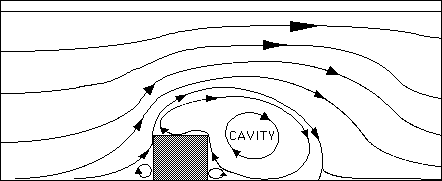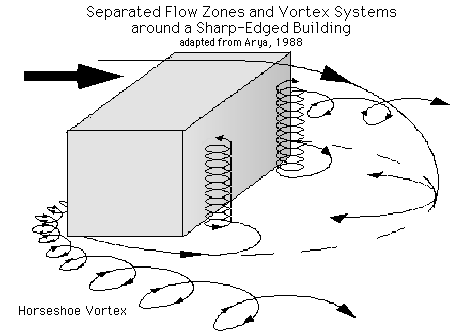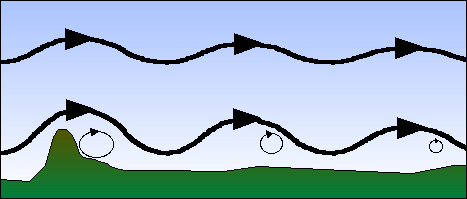

Notice first of all that a circular cavity of relatively slow moving air forms on the lee side (downwind side) of the building. The air in this cavity does not mix efficiently with other air; instead, it tends to circulate within the cavity and not leave the area. This cavity has the potential to aquire high concentrations of any substances introduced into the rotation because the air does not mix with outside air. Notice also two other smaller rotations that form near the base of the building on both the windward (upwind side) and lee sides. The flow that surrounds and is affected by the obstruction is known as the wake. The effect of the wake weakens with increasing distance from the obstruction. When we look at the same building and flow in a 3-dimensional view, we notice more complex features.

From this perspective, the wind pattern is much more intricate. To illustrate other flow patterns, the main cavity has been removed. Here, two features really stand out -- the two vertical vortices on the lee side of the obstruction and the horizontal vortex system (called the horseshoe vortex). If you were to add sufficient heating to the system, the situation would become even more complex, with eddies and vortices rising into the unstable atmosphere.
Street Canyon Effect
When we put several buildings together, we get even more complex flows. Such flow patterns are highly turbulent and very unpredictable. However, we can generalize a few patterns. When buildings are relatively close (distance between them being less than 10 to 20 building heights, which is nearly always the case in urban areas), the cavities and wakes on the lee sides interact with each other. Depending on the spacing and size of the buildings, the cavities can allow strong vortices to develop on the lee sides of buildings along canyons which are normal (perpendicular) to the background flow. Also, highly gusty wind can flow between buildings in the canyons which are more parallel to flow. These are known as street canyon effects. Winds which blow through these canyons can reach unbelieveable speeds. In fact, they can attain such high velocities that they cause damage. Air moving at high speeds creates lower pressure than air moving at slow speeds. Therefore, the wind blowing through street canyons can reach high enough speeds, and low enough pressures, that windows along the street canyon are sucked out of the buildings (the pressure inside the buildings is much higher, creating a pressure gradient that forces the windows to pop out). This reduction of pressure due to such high speed winds through street canyons is know as the Bernoulli Effect.
Rotors
The above obstruction situation is just one example to illustrate the complexity of microscale flow. Similar patterns occur on different scales over mountains, hills, and any type of flow obstruction. If the atmosphere is sufficiently unstable on the lee side of hills and mountains, cavities such as those above can form repeatedly at specific distances downwind due to the sinusoidal motion created by the obstruction. These closed circulations are known as rotors.
As we get deeper into air flow near obstructions and closer to air movement at smaller scales, we approach the subject field of fluid dynamics. Meteorology deals with fluid dynamics on the simplest levels, and so we mention briefly the above flow patterns. However, we will not go into further detail about fluid dynamics. Instead, we will shift the focus slightly toward another type of scale: grid scales.

 The Shodor
Education Foundation, Inc.
The Shodor
Education Foundation, Inc.